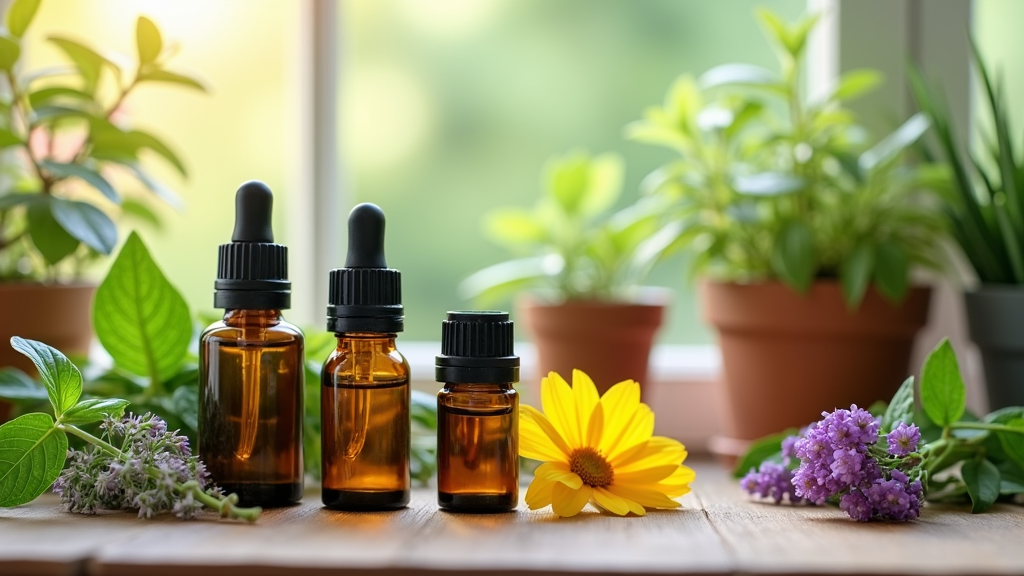Using essential oils in gardening is a creative way to step up plant health and add a natural defense against common pests and diseases. It appeals to anyone who prefers a more natural yard, is careful about using chemicals, or just wants to see their plants thrive. As someone who enjoys experimenting with homegrown solutions, I’ve found essential oils can be a game-changer in the garden when used the right way. Here’s a super detailed look at how these plant-based oils can make a real difference, along with practical tips to help anyone get started.

Why Essential Oils Are Useful for Gardens
Essential oils can add an extra layer of protection to your garden by keeping away insects, discouraging fungal growth, and even attracting helpful pollinators. They’re made from distilled plant parts, which means they bring over some of the same traits that help those plants survive in the wild.
The interest in natural gardening has really picked up, partly because many people want to cut down on synthetic chemicals. Essential oils offer a safe, ecofriendly alternative when used thoughtfully. Market trends for organic gardening products are going in a strong direction, too, as more folks look for green solutions that work. Whether you want to keep your vegetable beds chemical-free or just help your ornamental plants thrive without harsh products, these oils might be the solution you’re looking for.
Using essential oils isn’t just about pest control. Many gardeners report better plant vigor and reduced fungal problems. This approach has been used around the world for centuries, especially in regions that have long relied on aromatic herbs for both cooking and home remedies. In some cultures, essential oils have been used as natural disinfectants for centuries, showcasing a time-tested tradition of tapping into plant power.
Getting Started With Essential Oils in the Garden
Figuring out which essential oils are best for gardening is pretty straightforward once you know what they do. Some oils target pests, others help reduce diseases, and a few can even attract beneficial insects to support natural pollination. No matter your level of experience, experimenting with these oils can be a great way to game plan your garden care and cut down on chemical use.
The most important step is to choose high quality, pure essential oils because cheap blends or synthetic versions won’t give the same result. A little oil goes a long way, so investing in a few small bottles can last you an entire growing season. Here are some top picks for garden care:
- Peppermint Oil: Repels ants, aphids, and spiders without any lingering odor on produce.
- Lavender Oil: Keeps moths, fleas, and mosquitoes away, while attracting pollinators like bees and butterflies.
- Tea Tree Oil: Fights off fungal problems such as mildew and black spot.
- Lemongrass Oil: Deters mosquitoes and some garden beetles, and its citrus scent freshens the air.
- Eucalyptus Oil: Helps repel snails and slugs, and masks the scent trails that some pests use to locate plants.
Other useful oils include rosemary, thyme, clove, and citronella. Each brings its own effect, but together they cover most of the problems you’ll face in the garden.
How to Safely Use Essential Oils With Plants
Getting the mix right is really important. Pure essential oils are potent, so you’ve got to dilute them before spraying anywhere near your plants. If used straight out of the bottle, they can damage leaves or block out sunlight. Even though these oils are natural, they still pack quite a punch; always treat them with the same precaution you’d use with any concentrated product.
- Pick Your Base: Blend the oil with water and a little mild liquid soap (as an emulsifier).
- Mix Carefully: Use about 10 drops of essential oil per ½ liter (about 2 cups) of water, with a few drops of liquid soap.
- Test First: Spray a small patch on one plant leaf. Wait 24 hours to make sure there’s no damage.
- Apply Sparingly: Mist plants early in the morning or late in the afternoon to avoid sunburn.
If you’re working with especially sensitive plants, like tomatoes or herbs, start with half the usual amount of essential oil to check for leaf reaction before applying more broadly. It’s always smarter to start small, see how the plant handles the treatment, and then game plan from there.
Some gardeners also add a little bit of neem oil to their mixes for added boost in pest control. Keep in mind that while combining products can be helpful, always try new blends on a single plant before applying them to your whole plot.
Common Problems Essential Oils Can Help With
Most people use essential oils for three main types of garden trouble: pests, fungal diseases, and unwanted critters. Here’s how I’ve seen them work in each case:
- Insect Pests: Aphids, spider mites, whiteflies, ants, and even mosquitoes dislike oils like peppermint, rosemary, or citronella. Spraying diluted oils on affected leaves once a week usually keeps bugs moving along.
- Fungal Diseases: Oils such as tea tree, thyme, and clove have properties that help plants resist powdery mildew and other garden fungus. Use at the first sign of trouble for best results.
- Animal Intruders: Mice and other small mammals hate peppermint and eucalyptus oil, so applying these around garden borders can help keep them at bay without harming them.
Here is a link to find all these amazing oils:
https://referral.doterra.me/4740777
Pest Control Do’s and Don’ts
Using essential oils for pest control in the garden calls for a bit of common sense:
- Don’t over-apply. More oil doesn’t always mean better results, and can risk plant damage.
- Always check for sensitivity on each new crop or plant variety you try oil sprays on.
- Reapply after heavy rains, since water can wash away the oils.
Staying sharp about how much and how often you use oils is the secret to protecting plants without causing harm. Remember to read up on your specific plant types to make sure you’re not making things worse instead of better.
Things to Consider Before Using Essential Oils in the Garden
There are some challenges with using essential oils for plant care, just like with any new gardening method. Here’s what I always pay attention to:
- Concentration: Too strong a mix may burn leaves, especially on tender seedlings.
- Plant Sensitivity: Plants like basil or ferns tend to be more sensitive, so always dilute extra for these.
- Frequency: Regular, light applications beat dumping on a lot at once. This is especially true in hotter weather.
- Cost: Quality oils cost more. Since you use so little, the bottle lasts a while, but it’s worth budgeting for.
Storing essential oils in a cool, dark place also helps them last longer, giving you more bang for your buck with each bottle. Always label your mixes with contents and date, so you never have to guess what’s inside or how old it is.
Mixing & Dilution
I always follow safe dilution rates and never exceed what experienced gardeners recommend. For most uses, 8-12 drops per 500ml spray bottle gives good coverage. For houseplants, or if the weather is very hot, I thin it out even more. Don’t be afraid to adjust as you get to know what your plants need.
Companion Planting & Oils
Pairing essential oils with companion planting makes pest control even easier. If you’ve already got marigolds, basil, or chives growing, a little extra boost with oil sprays helps keep those pesky bugs at arm’s length. This layered approach is safer for pollinators too. Mixing in flowers that naturally attract good bugs along with smart oil use makes your garden’s defenses extra strong.
Advanced Tips and Tricks
Once you’re comfortable with the basics, some creative uses can really pump up your garden’s health and eye-catching beauty. Here are my favorite next-level tricks:
Attract Pollinators: Dab cotton balls with lavender or sweet orange oil and place them near flowering plants. Pollinators love them, but most pests don’t.
Ward Off Deer and Rabbits: Spritz garden edges and fences with rosemary or peppermint oil diluted in water to discourage unwanted snacking.
Custom Mixes: Blend several oils to target tough pest combos. For example, a mix of peppermint, tea tree, and citronella works on many bug issues at once.
Use as a Cleaning Agent: After pruning or harvesting, wipe garden tools with tea tree oil diluted in rubbing alcohol to keep bacteria and fungus off your plants next time.
Some gardeners also experiment with diffusing oils outdoors to mask attractants or highlight particular scents. This can be especially useful in small greenhouses or shaded patios where airflow is limited. Incorporating these creative methods can step up both functional and aesthetic benefits in your garden.
“Here’s a little transparency: Our website contains affiliate links. This means if you click and make a purchase, we may receive a small commission. Don’t worry, there’s no extra cost to you. It’s a simple way you can support our mission to bring you quality content.”
Real-Life Examples
Many gardeners who felt stuck with constant aphid infestations have seen good results using diluted peppermint oil. In one backyard test, I noticed a major drop in spider mite activity after two applications of a rosemary oil spray each week. Others have told me that a blend of thyme and clove helped beat back fungus in humid climates, where mildew was a recurring problem.
Fungal issues on roses, like black spot or mildew, are tough to handle, but a tea tree spray used right after rainstorms made a real difference in leaf health. Friends who struggled for years with whitefly swarms on squash and cucumbers found some relief from regular spritzes of eucalyptus oil.
- Herb Garden: Using mint oil on the soil surface helps stop ants from entering leafy green beds.
- Flower Borders: Lavender and thyme oil sprays cut back powdery mildew on zinnias and dahlias without harming blooms.
- Vegetable Beds: Tomato plants treated lightly with eucalyptus oil early in the season had fewer whiteflies and seemed to grow stronger all summer. Pepper and cucumber plants also showed fewer signs of stress when oil sprays were used alongside mulch and steady watering.
Frequently Asked Questions
Here are the questions I hear most often about using essential oils for plant care:
Question: Can I use any essential oil in my garden?
Answer: Not all essential oils are good for plants. Stick to commonly recommended ones like peppermint, lavender, and tea tree, and always dilute before use.
Question: Will essential oils hurt pollinators?
Answer: Used sparingly, most oils are safe for bees and butterflies, but avoid direct spraying on flowers in bloom just in case.
Question: How often do I need to reapply?
Answer: Usually once a week or after heavy rain. You might need more often during a tough pest season, but watch for leaf damage if you do.
Question: Can essential oils be used on all edible plants?
Answer: Yes, as long as you dilute them well and stick to safe oils like peppermint and lavender. Always wash produce thoroughly before eating and avoid spraying right before harvest to keep flavors pure.
Final Thoughts
Using essential oils for gardening brings natural pest protection and helps plants look their best without harsh chemicals. They’re simple to use with a little practice and work especially well alongside other organic gardening techniques. Careful testing and gentle application let gardeners make the most of these potent oils, showing that even something as simple as a plant’s own fragrance can make a garden stronger and more beautiful.
A few small bottles, a little knowhow, and some consistent application are all you really need to get healthier, happier plants this season. With patience and attention, you’ll stumble upon methods that work best for your own space, making every corner of your garden pop with life and color.
